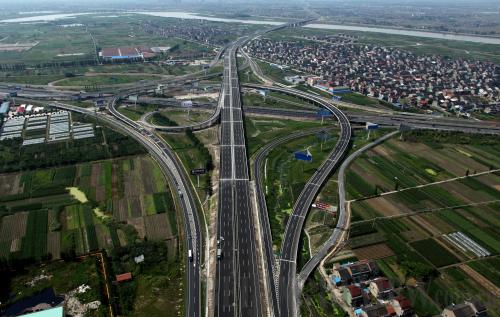|
 |
|
DEVELOPED TRANSPORTATION: Jiaxing-Shaoxing River-Crossing Bridge, Hangzhou-Ningbo Expressway and Shangyu-Sanmen Expressway get crossed at Guzhu in Shangyu, east China's Zhejiang Province, on July 6, 2013 (XINHUA) |
For the past two years, China's economy has slowed down. According to statistics released by the National Bureau of Statistics (NBS) on July 15, China's gross domestic product (GDP) grew by 7.6 percent in the first half of the year. In the second quarter, the GDP growth was a mere 7.5 percent, the second lowest since the fourth quarter of 2010.
But skeptics be warned: The slower growth doesn't mean you can dismiss China's economy just yet. NBS spokesman Sheng Laiyun says China's economic growth is stable and economic restructuring—that is, shifting China toward more consumption—was progressing steadily.
China is trying hard to reduce its dependence on investments and shift its economy to a growth mode that is more sustainable in the long run. Its growth rate is in line with the Central Government's expectations and plans to transform the economy.
Liu Yuanchun, Associate Dean of the School of Economics at Renmin University in Beijing, suggests that the harm to China's economy does not stem from a slowdown but comes from rapid growth during the restructuring phase. Therefore, the slowdown is a good thing for China's long-term plans. Skeptics should look beyond the slowdown and pay more attention to the government's ambitious economic reforms and restructuring instead.
A temporary slowdown
Statistics from the NBS show that China's agricultural output experienced a steady increase in the first half year, and food security was secured by a summer grain crops harvest, which witnessed a 1.5-percent increase from the previous year. Industrial manufacturing saw steady growth; and corporate profits continued to increase. These figures suggest that China's economy rests on a solid foundation.
Statistics also show that during the same period, the per-capita disposable income of China's urban residents registered a nominal increase of 9.1 percent year on year and the per-capita cash income of rural residents increased 11.9 percent, a clear indication that slower growth hasn't dragged incomes down.
Lian Pingyan, chief economist at the Bank of Communications, noted that concerns over a slowdown are exaggerated because figures like the employment rate and commodity prices were normal.
Zhang Liqun, a research fellow from the Development Research Center under the State Council, China's cabinet, believes that China had entered a period of moderate economic growth, one that is moving at an appropriate pace. "China's economy is bottoming out and seeking a new balance," said Zhang.
Zhang said he is confident in the economy in both the short and long term since China is still in the midst of high-speed industrialization and urbanization.
Throes of transformation
China has been harassed by environmental pollution and resource waste during the past three decades of unbridled economic growth. Since the new government came into power in March, plans for more sustainable economic development and upgrading have assumed more focus.
As a result, plenty of red tape has been cut in a push to create more efficiency in the economy. In two meetings held in April and May, the Central Government decentralized its power and put more decision-making capability in the hands of provincial and municipal governments.
| 